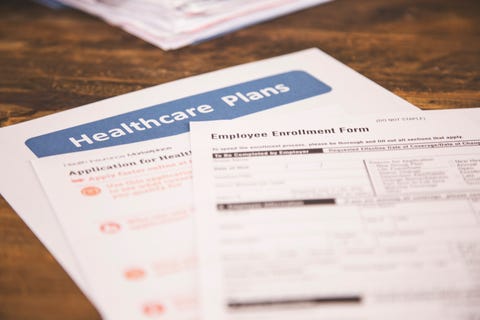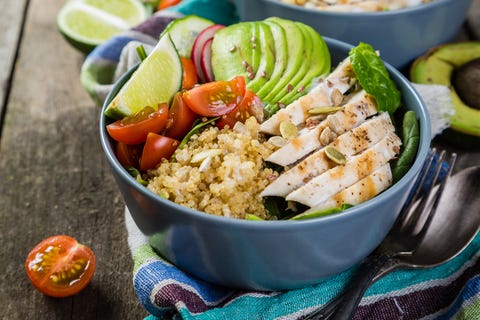You’re in your 20s, which means you might be focused on working out and feeling good, but you’re likely not thinking about the nitty gritty of your physical health. And we get it: Between going out with friends and figuring out exactly how to adult, you’ve got a lot going on.
But if you want to continue feeling great for years to come, you need a strong foundation. To start building that now, we recommend working toward three v. important (but totally do-able) goals and knocking them out of the park before the big 3-0 rolls around.
Here, we break down each one and give you all the intel you need to get the ball rolling.
1. First things, first: Get health insurance
fstop123Getty Images
Doctor appointments in your 20s are typically pretty uneventful, but that doesn’t mean you shouldn’t get health insurance. For one thing, it’s the law: The Affordable Care Act requires everyone to have health insurance that meets minimum standards —skip it, and you’ll pay a penalty at tax time. (Eek.😬)
🙌🏽 The payoff: Aside from avoiding the financial penalty, having health insurance allows you to have an annual physical at very little cost to you. Your physical gives you and your doctor a gauge of your overall health, and a heads-up about potential problems you may experience as you head into your 30s, 40s, and beyond, says Dr. Adil Arabbo, MD, a family physician at Detroit Medical Center Huron Valley-Sinai Hospital.
Think of these annual check-ups in your 20s as a compass pointing toward how you should move forward in terms of your health, says Dr. Arabbo.
There’s another big reason it’s good to have health insurance—even if you’re completely healthy: accidents. From breaking an arm to needing stitches, the costs of even a relatively simple appointment at an urgent care facility or the hospital can put a major dent in your budget. With a health insurance card in your wallet, it’s easier—and less expensive—to get treatment.
👉🏽 Getting started: Sure, finding insurance isn’t the most entertaining of activities, but it’s so worth it. And the task isn’t really that complicated—you can tackle it in an afternoon, or a few hours.
If your employer provides insurance, review your options during the next open enrollment period. If you have questions, don’t be shy: Talk to your HR representative, call up the insurance company for deets, or do a bit of research online. (This guide may come in handy!)
If you’re buying insurance from your state’s marketplace, browse on the site to see and compare your state’s options, and call providers with questions.
2. Find a workout routine that sparks joy ✨
Caiaimage/Sam EdwardsGetty Images
Finding a workout that you actually enjoy—whether it’s yoga at home or a weekly Spin class—will reduce the odds that you’ll skip your workout when the weather is crummy, you’re beyond tired, or you have killer period cramps. (We’ve all been there. Ugh!)
🙌🏽 The payoff: Along with helping to control your weight and reducing the risk of heart disease and some cancers, the National Institutes of Health (NIH) notes that regular workouts boost mood (thanks, dopamine!) and help manage stress.
But those benefits can only happen with regular activity. “If you don’t like your exercise routine and find it a chore to do, then you won’t stay with it long,” says Daniel Destin, ACSM, the manager of The Shipley Fitness Center at Newton-Wellesley Hospital.
👉🏽 Getting started: What’s the trick to finding an exercise you adore? Destin recommends keeping your personality in mind—introverts and lovers of alone time may prefer solo workouts (think: jogging, swimming laps, and so on), while social butterflies may gravitate toward group fitness.
If you have a tough schedule—early mornings, late nights, or unpredictable hours—try working out at home with a mat, band, and exercise ball, Destin says. Even just 20 minutes will make a big difference!
3. Learn to cook a few wholesome dishes
a_namenkoGetty Images
Prepared foods at the grocery store along with readily accessible takeout make it easy to offload the responsibility of feeding yourself. However, those easy-to-grab foods are often full of sodium and sugar, and generally, just not so great for you.
🙌🏽 The payoff: When you cook for yourself, studies suggest you’ll likely eat fewer calories, and you’ll also have total control over the quality of the ingredients you’re eating. Plus, it’s significantly cheaper. “You can eat pretty darn healthy for a small amount of money if you eat at home,” says Kelly Springer, RD, CDN, the founder of Kelly’s Choice.
👉🏽 Getting started: If you’re new to cooking, keep things simple. Springer—who admits she doesn’t love cooking—follows what she calls the “power of five”. For every meal, include at least three of the following food groups: protein, vegetables, dairy, whole grains, fruits. Here are some examples of easy meals that fit the bill:
Looking to master some more sophisticated dishes? Start by finding a recipe with 10 ingredients or fewer and make it regularly, once a week for a month. By the end of the month, you’ll be able to whip up the meal without consulting the instructions. Think of it as ammunition against the temptation of Seamless after a long day or tough commute.
Source: Read Full Article


